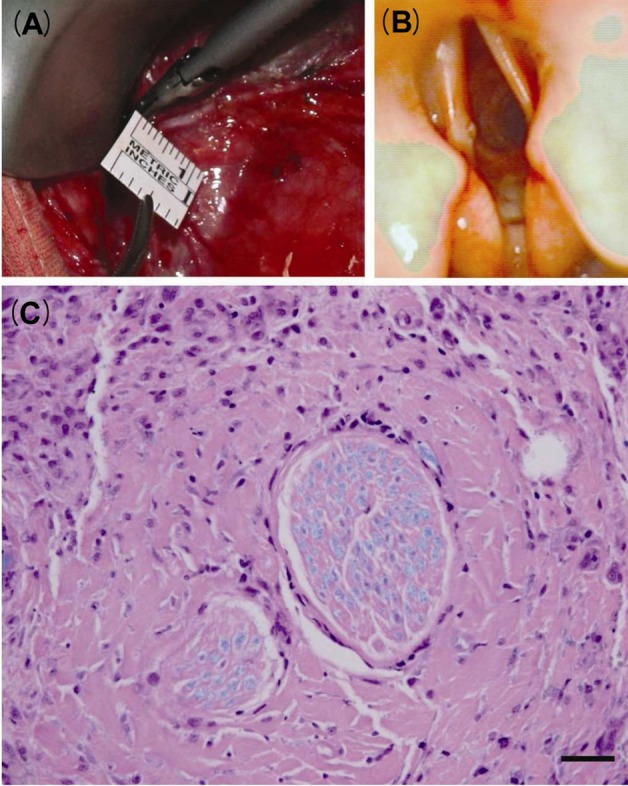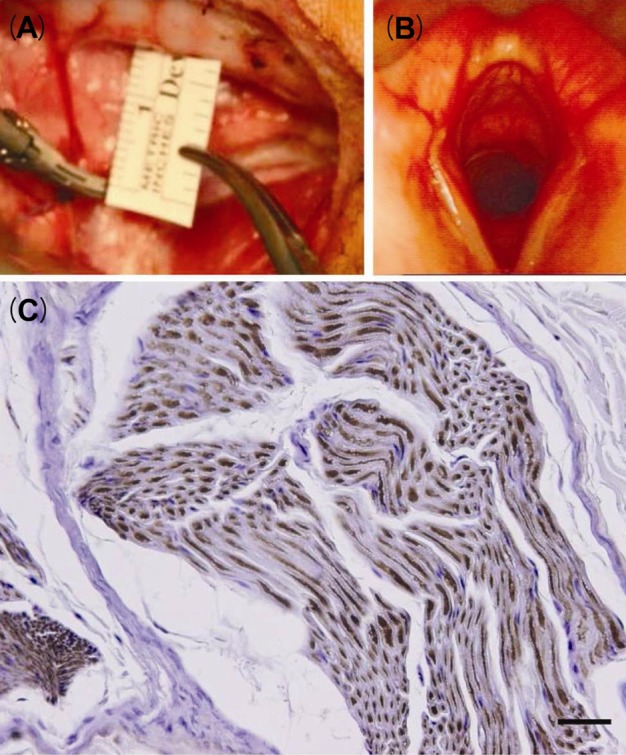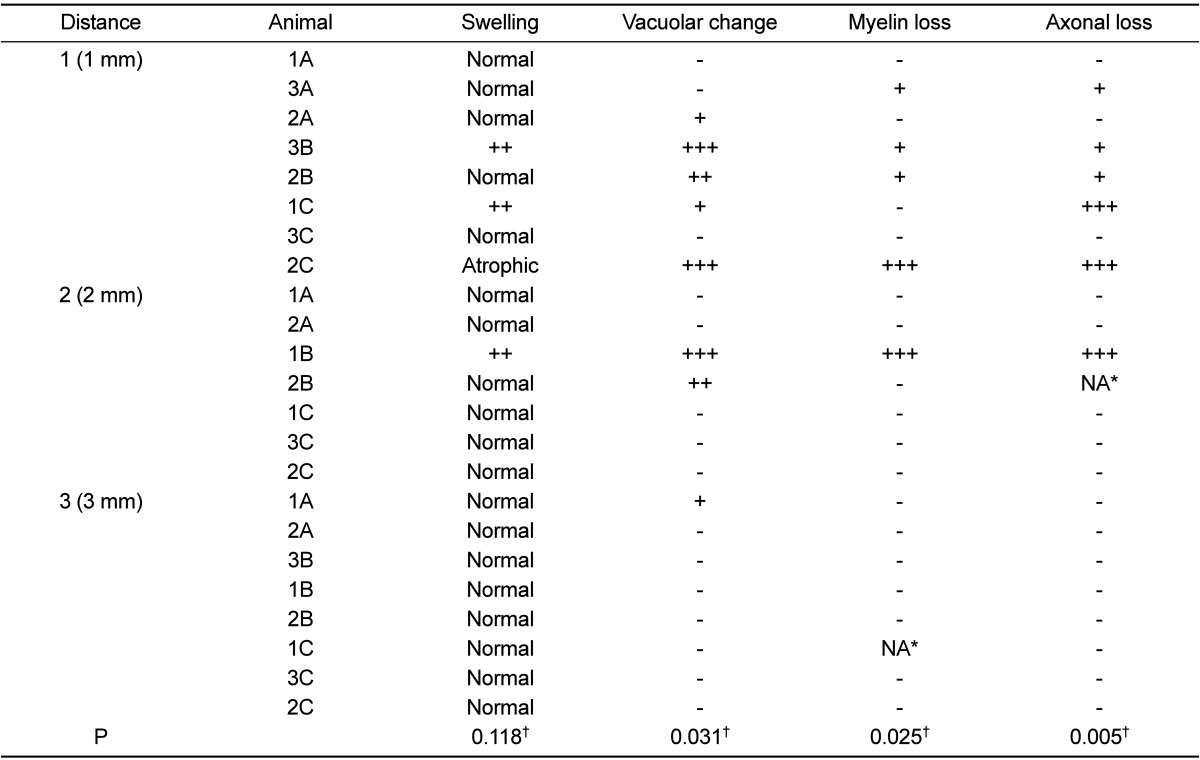Abstract
Various energy devices had been used in thyroid surgery. Aim of study is to develop canine model for recurrent laryngeal nerve injury by harmonic scalpel and to evaluate feasibility of using this model for evaluating the safety use of harmonic scalpel during thyroid surgery. Nine dogs were divided into 3 groups according to distance between harmonic scalpel application and recurrent laryngeal nerve; group 1 (1 mm), 2 (2 mm), and 3 (3 mm). Vocal cord function was assessed pre- and postoperatively using video laryngoscopy. Harmonic scalpel was applied adjacent to left recurrent laryngeal nerve and, two weeks later, right recurrent laryngeal nerve at assigned distances. Recurrent laryngeal nerves were evaluated for subacute and acute morphologic changes. Laryngoscopy demonstrated 3 abnormal vocal cords in group 1, 1 in group 2, and no in group 3 (P=0.020). Subacute histologic changes were observed in nerves with abnormal function. Acute histologic changes were observed 5/8 (62.5%) in group 1, 1/7 (14.3%) in group 2, and not in group 3. We developed canine model for recurrent laryngeal injury. The functional outcomes matched with the histologic changes. These warrant further study to determine the safety margin for energy device in vicinity of recurrent laryngeal nerve.
Keywords: Recurrent laryngeal nerve, canine model, harmonic scalpel, safety margin, nerve damage, ultrasonic shears
Over the last 10 years, innovative hemostatic devices, such as the electrothermal bipolar vessel sealing system and ultrasonically-activated shears, have been developed as welcome adjuncts to the thyroid surgeon's armamentarium [1]. There were several retrospective comparative studies which demonstrated use of the HS during thyroidectomy significantly reduces operating times and postoperative hypocalcaemia [2-5]. Also, several prospective randomized trials had proved the safety of HS as conventional surgery in terms of voice change and bleeding [6-8]. However, there is no large animal model to determine the clinically acceptable distance safety margin for the application of energy device in the vicinity of the recurrent laryngeal nerve and evaluate the vocal cord. Ong et al. used a canine model to compare the effect on cavernous nerve function of various energy sources and a conventional surgical technique during nerve sparing radical prostatectomy [9].
The aim of this study is to develop a canine model for recurrent laryngeal nerve injury by Harmonic scalpel (HS) device and to evaluate feasibility of using this model for evaluating the safety use of an energy device during thyroid surgery.
Materials and Methods
Operative procedures
The study was approved by the Institutional Animal Care and Use Committee of the Clinical Research Institute of Seoul National University Hospital (approval number 07156, 06-2006-210-9). Nine male dogs weighing 17 to 21.5 kg were assigned to one of 3 groups according to the distance that was to be maintained between the site of Harmonic scalpel (HS) application and the recurrent laryngeal nerve (RLN): (i) group 1 (1 mm); (ii) group 2 (2 mm); and (iii) group 3 (3 mm). The animals were administered 3 to 5mg/kg of intramuscular zolazepam as a premedication followed by 25 mg/kg of intramuscular cefazolin (Chong Kun Dang pharmaceutical corp., Seoul, Korea). Direct laryngoscopy was performed to assess vocal cord function. The animals were then intubated and administered 1% to 3% isoflurane as a general anesthetic. A midline skin incision of approximately 10 cm was made in the neck, and the left lobe of the thyroid and the left RLN were identified. Left thyroid lobectomy was performed. The HS (Harmonic Ace 36P; Johnson & Johnson Medical, Cincinnati, OH, USA) was applied near the RLN at the assigned distance. Low power HS (70 µm vibration) was applied for 10 seconds (Figure 1). A nonabsorbable suture was applied to facilitate subsequent harvesting of the nerve. The wounds were closed in multiple layers. To limit variability, all procedures were performed by the same surgeon, who was experienced in thyroid surgery. An aseptic technique was used throughout all procedures. An intramuscular injection of 0.4 mL/kg meloxicam was administered for postoperative pain control.
Figure 1.
Schematic illustration of initial (A) and second (B) operation. (A) After performing a left thyroid lobectomy, the harmonic scalpel (arrow) was applied near the recurrent laryngeal nerve at the assigned distance. (B) Two weeks after the initial operation, the left recurrent laryngeal nerve was harvested (dotted box). After performing a right thyroid lobectomy, the harmonic scalpel was applied to the tissue adjacent to the right recurrent laryngeal nerve at the assigned distance (arrow). All three fragments of right recurrent laryngeal nerve were harvested (dotted box).
One week later, the animals were administered 3 to 5 mg/kg of intramuscular zolazepam as a premedication, and repeat laryngoscopy was performed. Two weeks after the initial operation, the animals were returned to the operating theater for re-exploration. The neck was reopened and the left RLN was harvested. This was placed in formalin for histological evaluation of subacute morphological changes. The right lobe of the thyroid and the RLN were then identified. Right thyroid lobectomy was performed, and HS was applied to the tissues adjacent to the right RLN at the assigned distance (Figure 1). All three fragments of right RLN were immediately harvested and placed in formalin for histological evaluation of acute morphological changes.
Histological evaluation
One left RLN could not be located during reexploration. Thus, 3 left RLNs from groups 1 and 2, and 2 left RLNs from group 3 (a total of 8 nerves), were examined for the presence of subacute morphological changes. Nine right RLNs from each group (a total of 27 nerves) were evaluated for the presence of acute morphological changes. The specimens were embedded in paraffin, sliced to a thickness of 3-4 mm, and stained with hematoxylin and eosin. Immunohistochemical (IHC) analyses were performed using 4-µm-thick sections and the DAKO Autostainer Plus Link (Dako, Glostrup, Denmark). With the exception of primary antibodies, all IHC components were taken from the EnVision FLEX High pH kit (K8000; Dako, Glostrup, Denmark). Antigen retrieval was achieved by treating the tissue sections with EnVision FLEX Target Retrieval Solution (DM812; Dako, Glostrup, Denmark; Tris/EDTA buffer, pH 9) for 45 min at 95℃. The tissue sections were then incubated with mouse antihuman neurofilament monoclonal antibodies (NF; Dako, Glostrup, Denmark) at a dilution of 1:2,000 for 20 min at room temperature. EnVision FLEX Peroxidase-Blocking Reagent (SM801; Dako, Glostrup, Denmark) was used as the blocking buffer. Antibody binding was visualized with a peroxidaseconjugated polymer backbone (EnVision FLEX; SM802; Dako, Glostrup, Denmark) and the use of diaminobenzidine as a chromogen. The sections were then counterstained with hematoxylin. Appropriate positive control-tissues were used, and the omission of primary antigen was used as a negative control condition. Luxol fast blue (LFB) staining was used to identify myelinated white matter [10]. All histological analyses were performed by a single neuropathologist who was blind to the study group of the specimens. The neurovascular bundles were evaluated for the presence of swelling, vacuolar change, and atrophy, and for myelin and axonal loss.
Statistical analysis
The SPSS 15.0K® program for Microsoft Windows® was used for the statistical analyses. Linear by linear association and Spearman's correlation were performed. Differences were considered statistically significant when P was <0.05.
Results
Functional outcome
Normal vocal cord movement was observed in all animals prior to the initial operation. One week postsurgery, 2 cases of a fixed vocal cord and 1 case of decreased vocal cord motility were observed in group 1, 1 fixed vocal cord was observed in group 2, and no abnormalities in vocal cord mobility were observed in group 3 (P=0.020) (Table 1).
Table 1.
Histological evaluation of the left recurrent laryngeal nerve 2 weeks after harmonic scalpel application
*NA: not applicable. †Linear by linear association. ‡Spearman's correlation.
Histological outcome
A total of 8 left RLNs were examined for the presence of subacute damage. Subacute morphological changes such as swelling, vacuolar change, and myelin and axonal loss were observed in the nerves of animals with abnormal vocal cord function (Table 1, Figure 2 and 3). Nine right RLNs from each group (a total of 27 nerves) were evaluated for acute damage. Acute morphological changes such as swelling, vacuolar change, and myelin and axonal loss were observed in 5 of the 8 nerves from group 1, and in 1 of the 7 nerves from group 2, whereas no acute morphological changes were observed in any of the nerves from group 3 (Table 2).
Figure 2.

Functional and morphological results of an animal from group 1 (1 mm). (A) Operative field showing the harmonic scalpel being applied at a distance of 1 mm from the recurrent laryngeal nerve. (B) Postoperative vocal cord examination showing a fixed, paramedian left vocal cord. (C) Nerve stained with Luxol fast blue showing atrophic changes including marked myelin and axonal loss (Scale bar, 10 µm).
Figure 3.

Functional and morphological results of an animal from group 3 (3 mm). (A) Operative field showing the harmonic scalpel being applied at a distance of 3 mm from the recurrent laryngeal nerve. (B) Postoperative vocal cord examination showing normal mobility of the left vocal cord. (C) Neurofilament stained nerve demonstrating a normal appearance with no axonal loss (Scale bar, 10 µm).
Table 2.
Histological evaluation of the right recurrent laryngeal nerve immediately following harmonic scalpel application
*NA: not applicable.
†Spearman's correlation.
Discussion
Although many clinical studies for the usefulness of the HS during thyroidectomy speculated upon the safety of HS, it did not propose a safe distance for the application of HS in the vicinity of the RLN during thyroid surgery. This study aimed to develop a large animal model for recurrent laryngeal nerve injury by HS.
The majority of nerve injury studies have used a rodent sciatic nerve model as this is inexpensive, convenient, and involves straightforward histological analyses. Although the HS causes an increase in the temperature of adjacent tissues, the spread of heat is less than that associated with bipolar or monopolar coagulation [11]. A study of pig arteries reported that the mean length of thermal spread was 1.6~2.4 mm [12]. A study of rat sciatic nerves found that the length of damage caused by ultrasonically activated scalpels was 0.9~1.1 mm [13]. In a further study of rat sciatic nerves, Owaki et al. concluded that use of the ultrasonic shears at a distance of 3 mm from the RLN for less than 10 seconds at level 3 was safe [14]. However, there is no large animal model to determine the clinically acceptable distance safety margin for the application of energy device in the vicinity of the recurrent laryngeal nerve. To our knowledge, the present study is the first to have examined the effect of HS application in the vicinity of the RLN during thyroidectomy in large animal. There is a study using the rabbit but it did not used laryngoscopy to evaluate the vocal cord function [15].
The canine model was selected since the vocal cords of dogs are more accessible than those of pigs, and are thus easier to evaluate the movement of the vocal cords by laryngoscope examination. Also, the anatomy of the thyroid gland is similar in dogs and humans, which facilitates the surgeons to mimic the real thyroid surgery as in human. In both species it is a dark red, elongated structure that is attached to fascia along the ventrolateral surfaces of the proximal trachea. The right thyroid lobe extends between the cricoid cartilage and the 5th tracheal ring, and the left thyroid lobe extends from the 3rd to the 8th tracheal ring. The gland is covered by the sternocephalicus and the sternohyoideus muscles ventrally and by the sternothyroideus muscle laterally. The common carotid artery, the internal jugular vein, and the vagosympathetic trunk are situated on the dorsolateral surface of the right thyroid lobe, and the esophagus lies over the dorsolateral surface of the left thyroid lobe. The caudal laryngeal nerves, termed the RLNs in humans, are dorsal to the thyroid lobes [16].
In this study we used 9 dogs for evaluation of both functional and histological outcomes. For histological outcomes both acute and subacute changes were evaluated using both sides of recurrent laryngeal nerves. As depicted in the results, there were functional abnormalities in the group 1 and 2, which were the groups of dogs with HS application in vicinity of less than 3 mm. In contrast, the group 3 with HS application with safety margin of 3 mm, there were no adverse outcomes. This is small sample size, however, conjunction with the study by Owaki et al. we could postulate a safety margin of 3 mm could be used [14].
Subacute morphologic changes were evaluated using left recurrent laryngeal nerves harvested 2 weeks after initial energy source application. Subacute changes were observed in the nerves of animals with abnormal vocal cord function. Acute morphological changes were evaluated using right recurrent laryngeal nerves harvested immediate after energy source application during second operation. Acute changes were observed in group 1 and 2, which were the groups of dogs with HS application in vicinity of less than 3 mm. In contrast, the group 3 with HS application with safety margin of 3 mm, there were no adverse acute morphologic changes. We could depict from these results that the histologic changes could be matched with the functional outcomes. The anatomical and functional correlation of this canine model might provide a rationale to evaluate the safety margin of an energy device during thyroid surgery.
This study has some limitations including; (1) have small sample size, (2) did not evaluated other energy sources, (3) have other ways to evaluate the function, such as electromyography, and (4) have short period observation after application of energy source. However, this study would warrant further study to determine the clinically acceptable distance safety margin for the application of an energy device in the vicinity of the recurrent laryngeal nerve.
References
- 1.Manouras A, Markogiannakis HE, Kekis PB, Lagoudianakis EE, Fleming B. Novel hemostatic devices in thyroid surgery: electrothermal bipolar vessel sealing system and harmonic scalpel. Expert Rev Med Devices. 2008;5(4):447–466. doi: 10.1586/17434440.5.4.447. [DOI] [PubMed] [Google Scholar]
- 2.Ortega J, Sala C, Flor B, Lledo S. Efficacy and cost-effectiveness of the UltraCision harmonic scalpel in thyroid surgery: an analysis of 200 cases in a randomized trial. J Laparoendosc Adv Surg Tech A. 2004;14(1):9–12. doi: 10.1089/109264204322862289. [DOI] [PubMed] [Google Scholar]
- 3.Siperstein AE, Berber E, Morkoyun E. The use of the harmonic scalpel vs conventional knot tying for vessel ligation in thyroid surgery. Arch Surg. 2002;137(2):137–142. doi: 10.1001/archsurg.137.2.137. [DOI] [PubMed] [Google Scholar]
- 4.Miccoli P, Berti P, Dionigi G, D'Agostino J, Orlandini C, Donatini G. Randomized controlled trial of harmonic scalpel use during thyroidectomy. Arch Otolaryngol Head Neck Surg. 2006;132(10):1069–1073. doi: 10.1001/archotol.132.10.1069. [DOI] [PubMed] [Google Scholar]
- 5.Manouras A, Markogiannakis H, Koutras AS, Antonakis PT, Drimousis P, Lagoudianakis EE, Kekis P, Genetzakis M, Koutsoumanis K, Bramis I. Thyroid surgery: comparison between the electrothermal bipolar vessel sealing system, harmonic scalpel, and classic suture ligation. Am J Surg. 2008;195(1):48–52. doi: 10.1016/j.amjsurg.2007.01.037. [DOI] [PubMed] [Google Scholar]
- 6.Defechereux T, Rinken F, Maweja S, Hamoir E, Meurisse M. Evaluation of the ultrasonic dissector in thyroid surgery. A prospective randomised study. Acta Chir Belg. 2003;103(3):274–277. doi: 10.1080/00015458.2003.11679422. [DOI] [PubMed] [Google Scholar]
- 7.Voutilainen PE, Haglund CH. Ultrasonically activated shears in thyroidectomies: a randomized trial. Ann Surg. 2000;231(3):322–328. doi: 10.1097/00000658-200003000-00004. [DOI] [PMC free article] [PubMed] [Google Scholar]
- 8.Kilic M, Keskek M, Ertan T, Yoldas O, Bilgin A, Koc M. A prospective randomized trial comparing the harmonic scalpel with conventional knot tying in thyroidectomy. Adv Ther. 2007;24(3):632–638. doi: 10.1007/BF02848788. [DOI] [PubMed] [Google Scholar]
- 9.Ong AM, Su LM, Varkarakis I, Inagaki T, Link RE, Bhayani SB, Patriciu A, Crain B, Walsh PC. Nerve sparing radical prostatectomy: effects of hemostatic energy sources on the recovery of cavernous nerve function in a canine model. J Urol. 2004;172:1318–1322. doi: 10.1097/01.ju.0000139883.08934.86. [DOI] [PubMed] [Google Scholar]
- 10.Fukuda S, Nakamura T, Kishigami Y, Endo K, Azuma T, Fujikawa T, Tsutsumi S, Shimizu Y. New canine spinal cord injury model free from laminectomy. Brain Res Brain Res Protoc. 2005;14(3):171–180. doi: 10.1016/j.brainresprot.2005.01.001. [DOI] [PubMed] [Google Scholar]
- 11.Koch C, Friedrich T, Metternich F, Tannapfel A, Reimann HP, Eichfeld U. Determination of temperature elevation in tissue during the application of the harmonic scalpel. Ultrasound Med Biol. 2003;29(2):301–309. doi: 10.1016/s0301-5629(02)00727-5. [DOI] [PubMed] [Google Scholar]
- 12.Harold KL, Pollinger H, Matthews BD, Kercher KW, Sing RF, Heniford BT. Comparison of ultrasonic energy, bipolar thermal energy, and vascular clips for the hemostasis of small-, medium-, and large-sized arteries. Surg Endosc. 2003;17(8):1228–1230. doi: 10.1007/s00464-002-8833-7. [DOI] [PubMed] [Google Scholar]
- 13.Carlander J, Johansson K, Lindström S, Velin ÅK, Jiang CH, Nordborg C. Comparison of experimental nerve injury caused by ultrasonically activated scalpel and electrosurgery. Br J Surg. 2005;92(6):772–777. doi: 10.1002/bjs.4948. [DOI] [PubMed] [Google Scholar]
- 14.Owaki T, Nakano S, Arimura K, Aikou T. The ultrasonic coagulating and cutting system injures nerve function. Endoscopy. 2002;34(7):575–579. doi: 10.1055/s-2002-33221. [DOI] [PubMed] [Google Scholar]
- 15.Jiang H, Shen H, Jiang D, Zheng X, Zhang W, Lu L, Jiang Z, Qiu M. Evaluating the safety of the Harmonic Scalpel around the recurrent laryngeal nerve. ANZ J Surg. 2010;80(11):822–826. doi: 10.1111/j.1445-2197.2010.05436.x. [DOI] [PubMed] [Google Scholar]
- 16.Hullinger R. The endocrine system. In: Evans H, Christensen G, editors. Miller's Anatomy of the Dog. Philadelphia, PA: W. B. Saunders Company; 1979. pp. 611–615. [Google Scholar]





